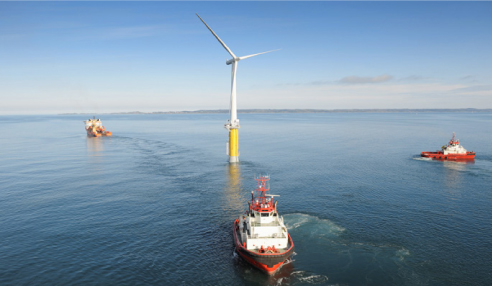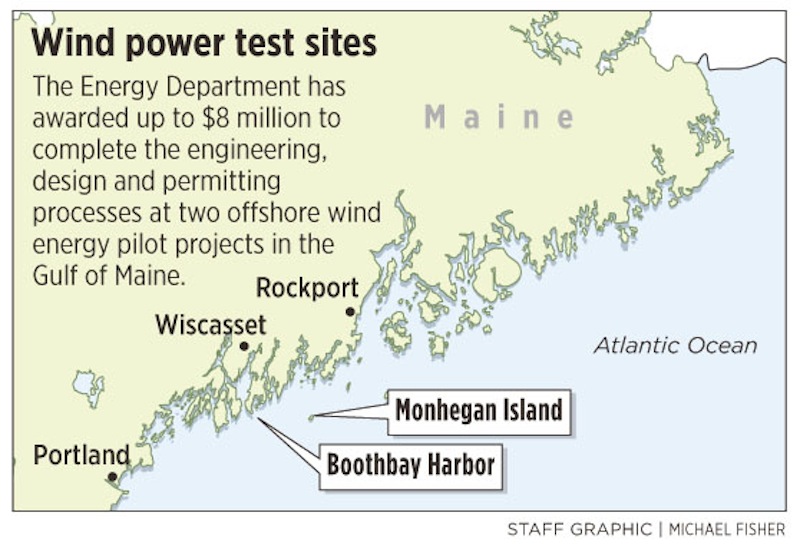Two proposed offshore wind projects in Maine have received important federal grants that officials say will help put the state at the forefront of developing a commercial, deep-water wind power industry.
U.S. Energy Secretary Steven Chu announced awards of $4 million each Wednesday, for projects near Monhegan Island and in the Gulf of Maine off Boothbay Harbor.
A team led by the University of Maine plans to install a pilot floating offshore wind farm with two, six-megawatt direct-drive turbines on concrete, semi-submersible foundations. The turbines will rise 300 feet above the ocean — taller than the Washington Monument — and have blades 500-feet in diameter.
Additionally, a project led by Stamford, Conn.-based Statoil North America plans to deploy four three-megawatt wind turbines on floating spar buoy structures off Boothbay Harbor, at a water depth of about 460 feet.
The spar buoys and the University of Maine project will be assembled in a harbor to help reduce installation costs, and then towed to the site to access extensive deep-water offshore wind resources.
Floating wind turbines can be placed further offshore, so they aren’t visible from land.
The Energy Department said the projects will help clear hurdles to installing utility-scale turbines in U.S. waters, connecting to the power grid and navigating new siting and permitting processes.
The Maine projects are two of seven awards that will help speed the deployment of stronger, more efficient offshore wind power technologies and showcase innovative technologies — helping to further lower costs and drive performance improvements.
In the initial phase, each project will receive up to $4 million to complete the engineering, design and permitting processes. The department will select up to three of the projects for follow-on phases that focus on siting, construction and installation and aim to achieve commercial operation by 2017.
The final projects will receive up to $47 million each over four years, subject to congressional appropriations.
“It’s probably the largest research grant to the state of Maine,” said Habib Dagher, the UMaine professor who has spearheaded the school’s Offshore Wind Laboratory.
Dagher said the university already has lined up roughly $42 million in private money to supplement the larger federal grant. The university also is planning to deploy a scale model of the technology next year off Monhegan Island.
Offshore wind represents a large, untapped energy resource for the United States that could generate four times the nation’s current total generation capacity.
According to a new report commissioned by the Energy Department, a U.S. offshore wind industry that takes advantage of this abundant domestic resource could support up to 200,000 manufacturing, construction, operation and supply chain jobs across the country and drive over $70 billion in annual investments by 2030. Offshore wind represents an economic and energy opportunity that could mirror the success of land-based wind development, the report said.
“The United States has tremendous untapped clean-energy resources, and it is important for us to develop technologies that will allow us to utilize those resources in ways that are economically viable,” Chu said. “Today’s announcement of awards to the first offshore wind projects in the U.S. paves the way to a cleaner, more sustainable and more diverse domestic energy portfolio that develops every source of American energy.”
The federal grants were praised by members of Maine’s congressional delegation, which has been especially active in advancing the university proposal.
“I am thrilled that the innovative deep-water offshore wind initiative, New England Aqua Ventus I, led by the University of Maine, has been selected by the U.S. Department of Energy for this competitive federal grant,” said Sen. Susan Collins, R-Maine. “This extremely important announcement is a vital step that could eventually help harness the vast potential of deep-water offshore wind energy and lead to the potential creation of some 20,000 new jobs.”
Seventy organizations applied for awards from the Advanced Technology Demonstration Program.
“This is a major grant and puts Maine at the center of the development of the offshore wind industry,” said Rep. Chellie Pingree, D-Maine. “The University of Maine has used advanced materials to create a technology that allows the turbines to be bigger and last longer in the harsh marine environment, and that is going to translate into lower energy costs.”
“I vehemently supported UMaine’s Aqua Ventus project and I am profoundly pleased that the proposal was approved, so our incredibly talented students and professors can begin work on this historic endeavor,” said Sen. Olympia Snowe, R-Maine.
Staff Writer Tux Turkel can be contacted at 791-6462 or at:
tturkel@pressherald.com
Copy the Story LinkSend questions/comments to the editors.





Success. Please wait for the page to reload. If the page does not reload within 5 seconds, please refresh the page.
Enter your email and password to access comments.
Hi, to comment on stories you must . This profile is in addition to your subscription and website login.
Already have a commenting profile? .
Invalid username/password.
Please check your email to confirm and complete your registration.
Only subscribers are eligible to post comments. Please subscribe or login first for digital access. Here’s why.
Use the form below to reset your password. When you've submitted your account email, we will send an email with a reset code.